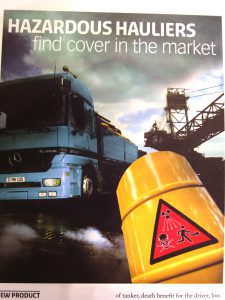At 21.00 on Wednesday 7 July 2010, while off Port Klang, Malaysia, the Master of the 8,000 TEU containership, M/V “CHARLOTTE MAERSK”, reported a fire on the foredeck of the vessel. The vessel and her cargo were badly damaged by the fire which reached 1,000º C in some places. Around 150 containers had to be opened and “surgically” extinguished (i.e. one container at a time). The fire could have resulted in the total loss of the vessel and her cargo.
It is believed that the fire originated in a container of calcium hypochlorite stowed below deck which was a “rogue” batch with a tendency to ignite at a lower temperature than would ordinarily be expected. Due to the incident, Maersk currently refuses to carry any calcium hypochlorite cargos from China.
Over the past decade, there has been a number of containership casualties involving calcium hypochlorite shipped out of China. In the English courts considered for the first time whether a rogue batch of calcium hypochlorite constituted a dangerous cargo and would therefore permit owners to recover their losses from the charterers or shippers.
The bill of lading and/or charterparty will generally contain an express or implied term prohibiting the shipment of dangerous cargo. The shipper and/or charterer is required not to ship cargo of an inflammable, explosive or dangerous nature which the owner did not agree to carry with knowledge of its nature and character and which damages directly or indirectly the vessel or other cargo on the vessel.
In the XYZ, as despondent owners, claimed against ABC, the shippers of the calcium hypochlorite, following a fire onboard the vessel while off the coast of Ecuador. The fire severely damaged the vessel and her other cargo. The cause of the fire was the self-ignition of the calcium hypochlorite cargo.
Calcium hypochlorite is a known dangerous cargo which the International Maritime Dangerous Goods (“IMDG”) Code requires to be stowed away from sources of heat and with a space of at least one container from any bunker tanks.
At the time of shipment, ABC had declared the cargo as calcium hypochlorite and cited the relevant part of the IMDG code. On its face, ABC had complied with its obligations to declare the contents of the container. ABC therefore argued that XYZ had agreed to carry the calcium hypochlorite and therefore could not claim against it for the damage to the vessel or its liability to other cargo owners.
Both parties put in extensive expert evidence concerning the characteristics of calcium hypochlorite generally and the characteristics of the cargo shipped. On the basis of the expert evidence, it was found that the cargo shipped was a rogue batch which would have ignited at a temperature of 25º C to 30º C rather than 60º C as would ordinarily be expected.
Accordingly, it was found that XYZ had not agreed to the carriage of this cargo with knowledge of its characteristics and XYZ were able to recover from ABC.
It should be noted that XYZ had been at fault as, in breach of the IMDG Code, they had stowed the container adjacent to bunker tanks which were heated during the course of the voyage. It was found however that, had XYZ complied with the IMDG Code in this respect, the cargo would still have been stowed below deck where temperatures would have exceeded 30º C. In the circumstances, it was found that the fault in relation to the stowage of the container was not causative of the loss (i.e. the cargo would have caught fire anyway).
The operative fault was in relation to the decision to heat the bunker tanks. This was an error in relation to the management of the vessel and an excepted peril under the Hague-Visby Rules. Accordingly, even if the fault had been causative, this would not have prevented XYZ from making a recovery.
The position would have been different if the loss had been due to unseaworthiness.
The shipment of rogue cargo is a major problem for the container industry. Readers will be reassured that English law is sufficiently flexible to deal with this issue in a way which is fair to the container operator. In this case, XYZ made a full recovery from ABC.
An obvious problem that can arise in similar situations is where the shipper of the dangerous cargo is much smaller than ABC and does not have the financial resources to meet the claim. In these circumstances, the owner may be able to claim instead against the charterer. The owner may also claim against the receiver, but only where the receiver has presented the bill to obtain delivery of the cargo. It is of course unlikely that the receiver would do this if there has been a major fire or a total loss.
In certain circumstances, an owner may be able to claim direct against the liability insurers of the shipper/charterer, under the Third Parties’ Rights against Insurers Act 2010, or against a parent/group company using the South African associated ship arrest rules or the United States “alter ego” rules.
Summary
The shipment of an undisclosed dangerous cargo or a rogue cargo can be an owner’s worst nightmare. While it is a particular problem for container vessels it is also a problem for bulk carriers, illustrated by the recent complications with the carriage of iron ore and nickel ore from India and Indonesia. In the event that damage is caused or additional expenses incurred, an owner will generally have a right to recover against the shipper and/or charterer. In certain cases, the owner may be able to enhance his recovery prospects by claiming against third parties such as receivers, insurers and parent companies.
This article was first published in The Swedish Club Triton November 2010.


